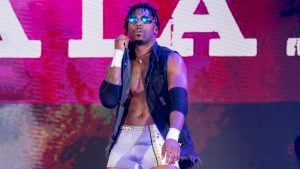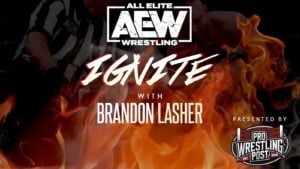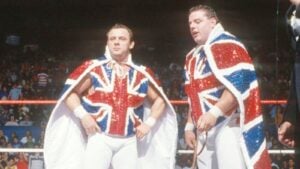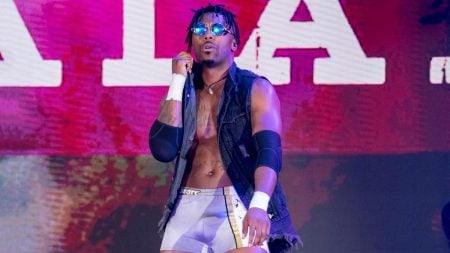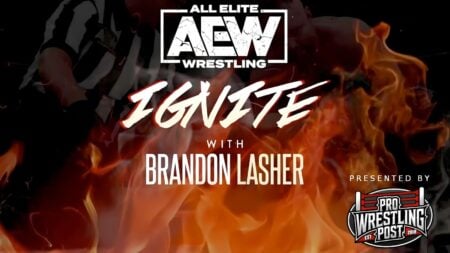From the days of grapplers plying their trade in the carnival circuit up to modern times, professional wrestling has been seen as the realm of the ‘tough guy.’
Stories abound of wrestlers who knocked out larger men or gritted their teeth and wrestled through gruesome injuries.
We bring up names like Haku, who can beat up entire crowds, or Kurt Angle, who captured a gold medal at the Olympics with a broken (freakin’) neck. In the wake of his passing in 2019, many such stories about one Harley Race were retold.
Over a 31-year career in the industry, Harley Race developed a reputation as a man it was seemingly impossible to harm.
He would take bumps that nobody had dreamed of taking before, taking drops onto concrete and doing some of the first table spots in wrestling history. He invented the diving headbutt, a move that drastically shortened the careers of other wrestlers who did it.
In his life, Harley Race survived shootings, stabbings, and a jackknife car crash that threatened to take his leg. Today we look back on the life and career of Harley Race, to see just what made him “the baddest man on God’s Green Earth.”
Harley Race –
Beginnings
Harley Race was born on April 11th, 1943, to sharecroppers Jay and Mary Race in Quitman, Missouri.
The young Harley experienced a difficult childhood, overcoming polio in his early years before earning a reputation as a troublemaker. He discovered pro wrestling watching cards from Chicago on the DuMont Television Network, and knew this would be his career.
His difficult family life led him to leave home at 14, and shortly thereafter he got a job working on a farm owned by WWI-era grapplers Wladek and Stanislaus Zbysko. When young Harley discovered the two had been wrestlers, he asked them to train him.
The brothers gave him a particularly old-school education in professional wrestling, putting him through a grueling training regiment when he wasn’t working the fields.
On weekends, Harley would wrestle for carnivals, earning his first paychecks in professional wrestling before he could legally drive.
At 16, Harley got into a fight at school, leading to the principal getting involved to break up the fight. In the scrum, the principal caught Harley in the head a few times with his knee, after which Harley laid into him with his fists.
Offered the opportunity to resume his schooling on the condition he apologized for his actions, Harley opted to leave school and pursue his pro wrestling ambitions.
Race drove 55 miles south to St. Joseph, where he began working for local wrestling promoter Gust Karras, who tasked the future world champion with handling Happy Humphrey, known at the time as the world’s largest wrestler.
At 700 pounds, Humphrey had to be driven around in a heavily modified 1951 Pontiac. Humphrey’s weight also made it difficult for him to fit into showers, so Harley would help clean him with a hose after matches.
For his services, Race was paid $5 a day plus room and board, plus $25 whenever he would referee or wrestle a match on the undercard, usually against Humphrey. Things were coming together slowly for Harley Race, but a tragedy would put all of it at risk.
Tragedy Strikes
On December 14th, 1961, at the age of 18, Harley married his first wife, Vivian Jones. Just 10 days later, the newlyweds were driving home in a snowstorm, when a semi-truck swerved into their lane to avoid a snowdrift.
The driver didn’t notice the oncoming car in time, and swerved back to the appropriate lane, jackknifing the trailer and sending the Races’ car 80 feet away. Harley and Vivian were pronounced dead at the scene of the accident, along with their unborn child.
However, Harley regained enough consciousness to move his arm, shocking the response crew. When Karras was informed of the accident shortly after, he rushed to the hospital, where he overheard that doctors were going to amputate Harley’s leg.
Unwilling to lose the young talent he had invested so much time and money in, Gust Karras physically prevented doctors from performing the surgery, claiming the doctors could remove Harley’s leg “Over my dead body.”
Doctors eventually decided to perform a much riskier surgery, and while they were able to save his leg, the prognosis was that Harley Race would never walk again.
However, Harley wasn’t going to let his wrestling dreams die without a fight. For the next few months, he undertook a grueling physiotherapy regime, and by the end of 1962, Harley Race returned to in-ring competition.
However, while he had begun wrestling in singles competition, Race felt it better to join the tag team ranks. And so, in late 1962, Harley went to Nashville, Tennessee, where he would become Jack Long, kayfabe brother of local babyface Johnny Long.
The Long Brothers would compete between Nashville and Memphis for just under half a year before Race would move to Boston, wrestling for the summer and autumn of 1963 as “The Great Mortimer ” for Jack Pfefer and Tony Santos.
However his time in the Northeast would be short lived, and he would soon move to Amarillo, Texas to work for Dory Funk, Sr. It was here that he made an important decision.
While talking with his father on the phone, Harley mentioned his search for a new ring name.
His father responded that he should be working to make his own name famous, rather than playing second fiddle to an established star. And so, Harley Race decided that he would work under his own name for the rest of his career.
AWA Tag Team Career
After working some dates for the American Wrestling Association in California under the name Jack Long, Race would go about establishing a name for himself in the Midwest.
During a 6-month run in Central States Wrestling, he would compete against veterans like Pat O’Connor, Angelo Poffo, and ‘Sailor’ Art Thomas, along with an up-and-coming Antonio Inoki.
In the fall of 1964, Race returned to the AWA to team up with Larry Hennig. As “Pretty Boy” Larry Hennig and “Handsome” Harley Race, the duo ran roughshod on the AWA roster, chalking up wins over Jack Lanza, The Crusher, and even promoter Verne Gagne.
Through extensive use of underhanded tactics, Race & Hennig would become the top heels in the territory, capturing the AWA World Tag Team Championships on January 30th, 1965.
However, two weeks later, Harley got involved in an altercation at The Chestnut Tree in Minneapolis.
Two customers had been harassing a female patron, and when Race intervened, one of the men (John Morton) pulled a knife and stabbed him. This proved only a minor setback to Race, who returned to in-ring competition less than a week later.

“Handsome” Harley Race & “Pretty Boy” Larry Hennig would hold the AWA World Tag Team Championship for a total of 777 days across three reigns.
Their major title defenses came against Dick The Bruiser & The Crusher, along with Verne Gagne, who teamed with multiple wrestlers to bring down Hennig & Race.
However, Hennig suffered a broken leg at a house show in Winnipeg in the fall of ’67, requiring extensive time off.
Race initially chose Chris Markoff to substitute for Hennig, but the duo lost the championships in their first title defense against Pat O’Connor and Wilbur Snyder.
Race & Markoff split ways unamiably, and Race would spend much of the interim teaming with Hard Boiled Haggarty. When Hennig returned from injury in April of 1968, the duo reunited.
However, this was a short-lived affair, as they would never again come within striking distance of the championships. At the end of 1968, Harley would depart from the AWA, choosing to seek his fortunes as a singles competitor in the National Wrestling Alliance
Singles Career
Race’s rise to the singles spotlight began in NWA Hollywood, where he wrestled against Crybaby Cannon and Medics #1 & #2, among others.
After unsuccessfully challenging NWA America’s Heavyweight Champion Bobo Brazil, and teaming up with “Classy” Freddy Blassie for an unsuccessful run at the NWA American Tag Team Championship, Race packed up and moved to Texas.
In NWA Western States, Harley Race re-ignited his feud with the Funk family, wrestling against Terry Funk and Dory Funk, Sr while challenging Dory Funk, Jr for the NWA World Heavyweight Championship.
Also in 1969, Race made his first appearances for Rikidozan’s Japan Pro Wrestling Alliance, facing Antonio Inoki and Giant Baba in tag team bouts.
On his return to Texas, he would wrestle fellow up-and-comer Dusty Rhodes, before resuming his feud with The Funks, while engaging in smaller feuds against Ricky Romero and Rufus R Jones.
However, this singles run hadn’t been what he’d wanted when he left the AWA. While he was almost universally recognized as a good worker with a strong in-ring psychology, the popular opinion was that Harley Race wasn’t ready for the main event.
So, he chose to leave Texas, re-settling in Missouri and Central States Wrestling.
In mid 1970, Race teamed up with Baron Von Raschke to capture the NWA North American Tag Team Championship from Bob Giegel and The Stomper.
They held the titles for 133 days before dropping the straps to Danny Little Bear and Rufus R Jones. However, at the beginning of 1971, Race would defeat Pat O’Connor to capture the NWA Central States Heavyweight Championship for the 2nd time.
This was a run that solidified Harley Race as a championship contender, holding the belt for a then-record 386 days, dropping the title to Danny Little Bear in February of 1972.
That year, he would recapture the Central States Championship along with the NWA Missouri Heavyweight Championship and the NWA North American Tag Team Championship along with Roger Kirby.
However, in 1973, the stars would align, and Harley Race would be the right man in the right place at the right time.
Perennial Contendership
The original plan for the NWA World’s Heavyweight Championship in 1973 was for reigning champion Dory Funk, Jr to drop the title to Jack Brisco, who also wrestled in a ‘brothers’ tag team in the 60s.
However, being that the champion belonged to NWA Western States, it was up to booker and promoter Dory Funk, Sr to approve that decision. However, the senior Funk was against the idea of his son dropping the title to another babyface with a similar story.
The Funks refused the match, citing injuries as the reason, but the NWA wasn’t buying it. Officials at the NWA approached Harley, known as a tough man and former carnival ‘shooter,’ with orders not to let Dory Funk, Jr walk out of the building as champion.
And so, on May 23rd, 1973, Harley Race defeated his hated rival to become the NWA World Heavyweight Champion. He would hold the title for 57 days before making the planned title change to Jack Brisco.
However, being champion meant traveling the major cities to defend the title, which he did almost nightly, against the likes of Bobo Brazil, Bruno Sammartino, Mr. Wrestling, and Thunderbolt Patterson. This was the run that cemented Harley Race as a perennial championship contender.

Though he swore he’d get his title back, from 1973 to 1977, Harley would bounce around between territories, winning regional titles in Florida, Georgia, Tennessee, and even in Canada.
On January 1st, 1975 Race defeated Johnny Weaver in a 2-out-of-3 falls match in Tallahassee, Florida to become the inaugural NWA United States Heavyweight Champion. Nowadays we know that title as the WWE United States Championship.
Picking up gold in every territory he worked in kept him in contention for the World Championship, and in 1977, he’d finally get his wish.
At a February 6, 1997 house show in Toronto, Canada, Harley Race would once again lock horns with Terry Funk, who’d captured the title from Jack Brisco almost a year and a half earlier.
The match was the bloody affair you’d expect from a Terry Funk/Harley Race match, and after just over 15 minutes, Race had won. He intended to make this second reign the one that counted most.
World’s Heavyweight Champion
With the “Ten Pounds of Gold” around his waist, Harley resumed the hectic schedule of the NWA World Champion.
Defending the title 6 nights a week, he would have matches against the likes of Angelo Poffo, Ernie Ladd, Rocky Johnson, and Chavo Guerrero Sr, as well as a series of rematches with Jack Brisco.
In total, his second run with the title would last 926 days. Even then, his stints without the title would last at most a week, with the likes of Dusty Rhodes, Tommy Rich, and Giant Baba each racking up a handful of days as champion before Race beat them again.
During this time, he would also defend the NWA World Heavyweight Championship against the top champions of other promotions, like the AWA’s Nick Bockwinkel and the WWF’s Bob Backlund and “Superstar” Billy Graham.
However, his greatest accomplishment as world champion came when he became the first man to bodyslam Andre the Giant on October 13th, 1978. On January 7th, 1979, he would repeat the feat, leading to a double count-out and retaining his belt.

However, things would start to slow down for Race in 1981, when he lost the belt to Dusty Rhodes for he second time.
Dusty’s second reign with the “Ten Pounds of Gold” would surpass his first, lasting 88 days before dropping the title to Ric Flair on September 17th, 1981. This would begin a turbulent time for the NWA World’s Heavyweight Championship.
The NWA suspended Dusty Rhodes, who returned to in-ring action as the masked “Midnight Rider,” capturing the championship from Flair in early 1982.
However, the NWA regulations forbade masked wrestlers from holding the World’s Heavyweight Championship, and The Rider surrendered the title back to Flair less than 24 hours later.
Shortly thereafter, Ric Flair and others would go on a tour of Puerto Rico, begrudgingly putting over local babyfaces Carlos Colon and Jack Veneno before scrambling back to the safety of the mainland USA.
That would not be the end of Flair’s worries, however, as Harley Race was waiting to challenge him again back at home. On June 10th, 1983, Race would defeat Flair to capture the NWA World’s Heavyweight Championship for a record-tying 7th time.
This seventh run with the Ten Pounds of Gold would be his most famous, as his feud with Ric Flair would change the face of professional wrestling as we knew it.
But more on that in part 2.
